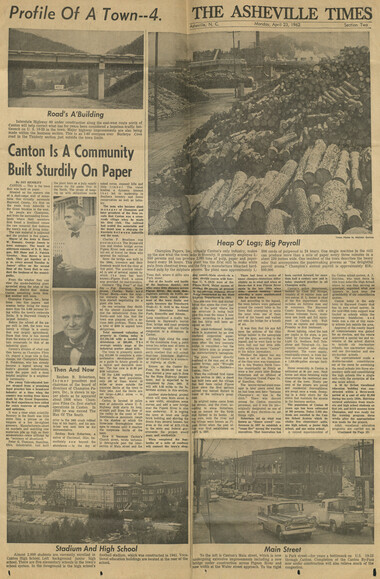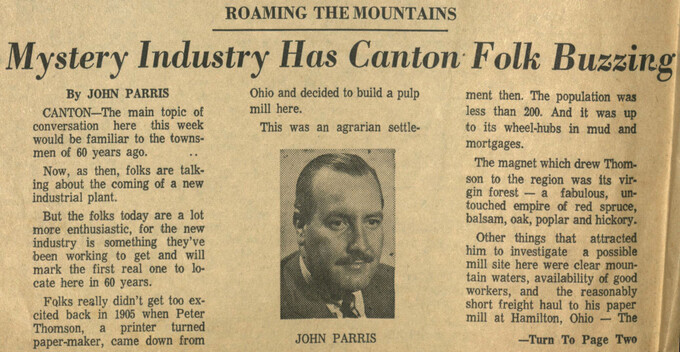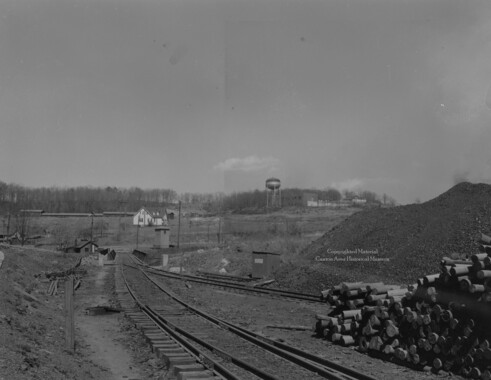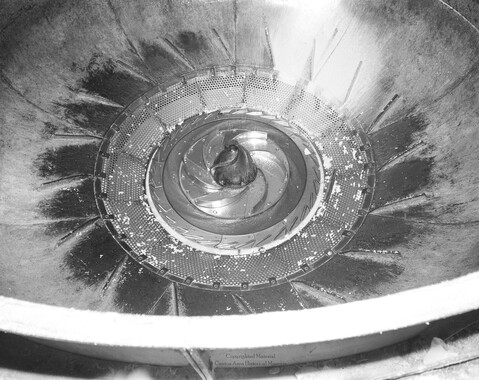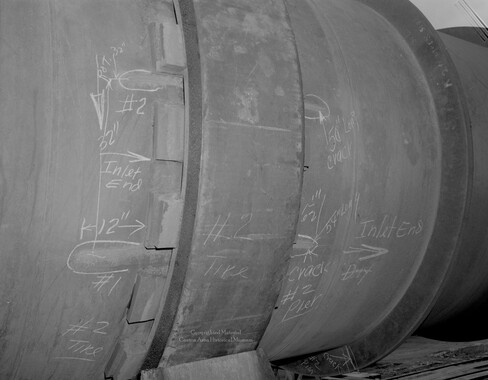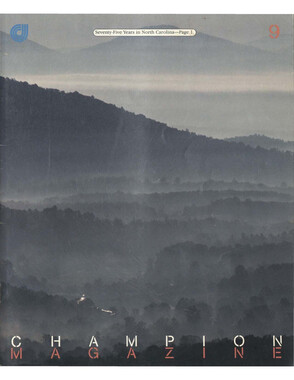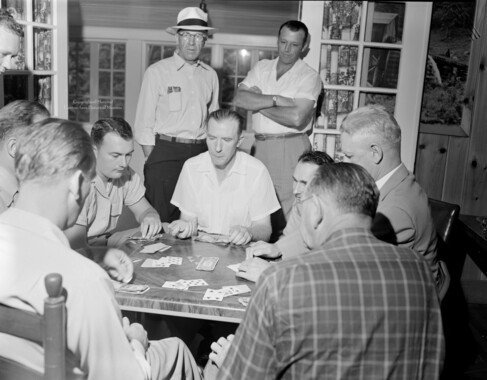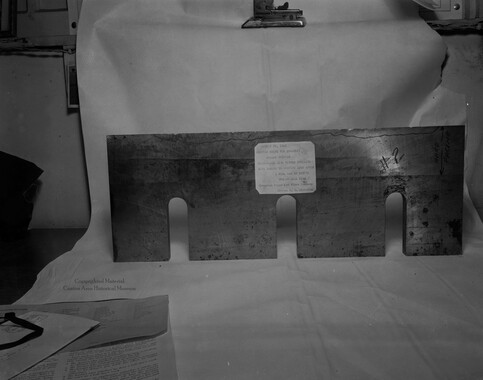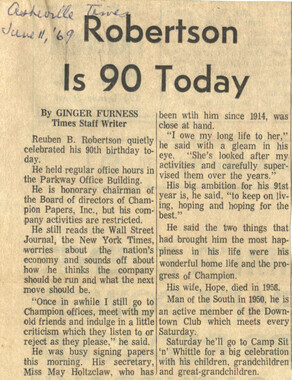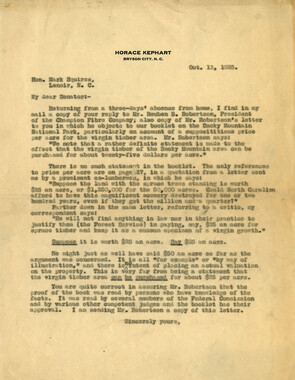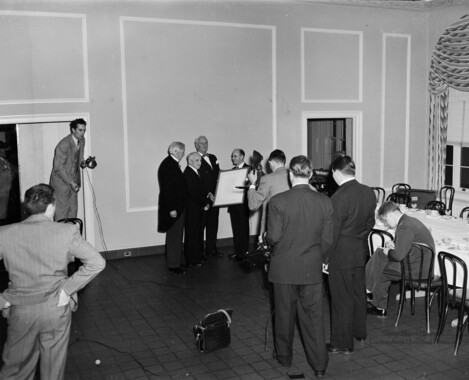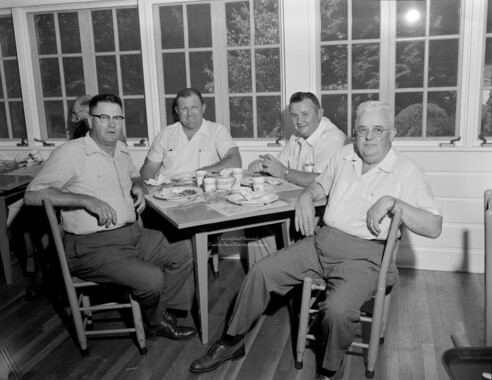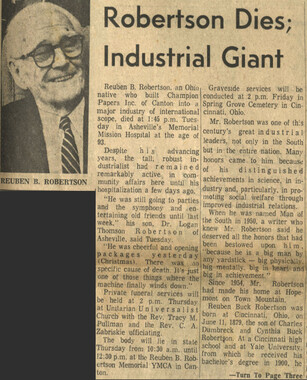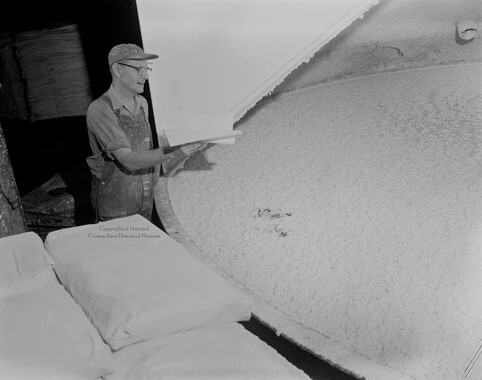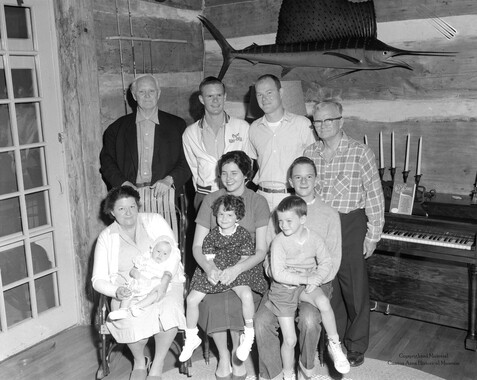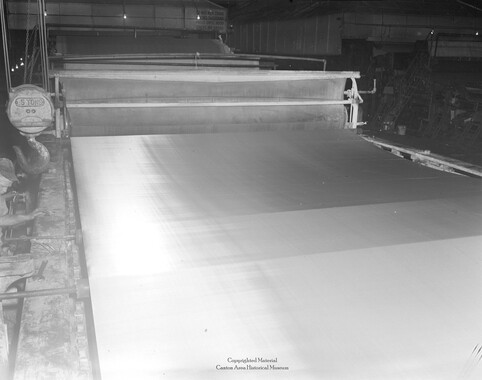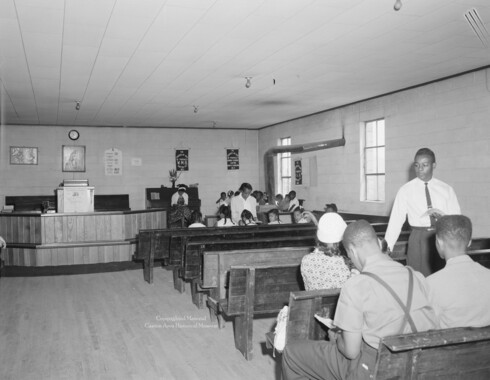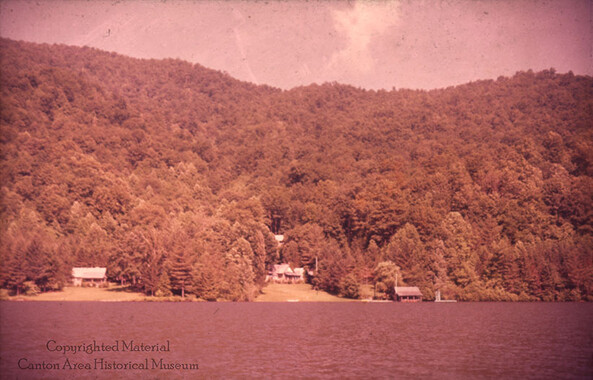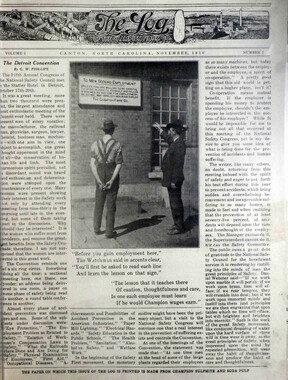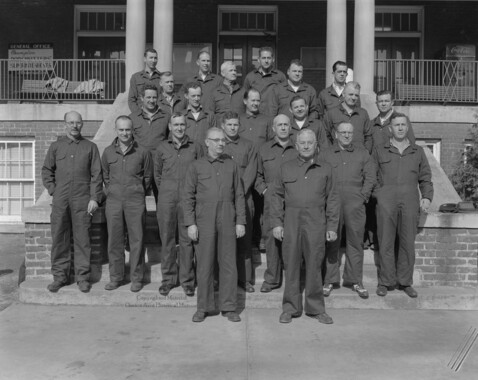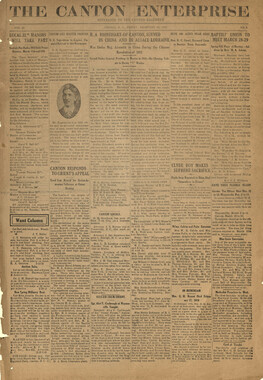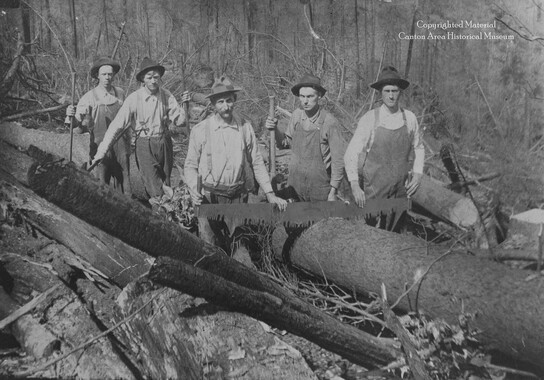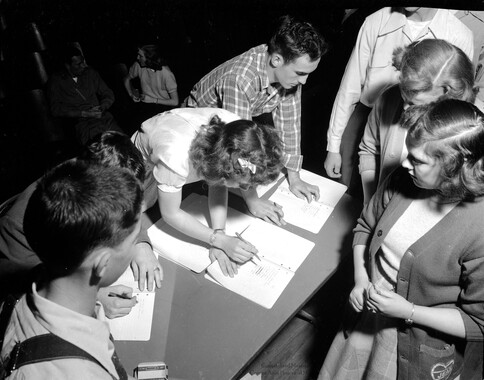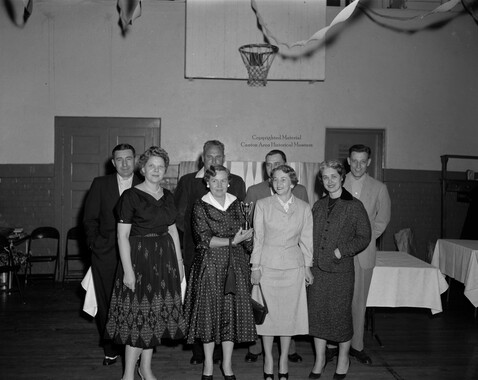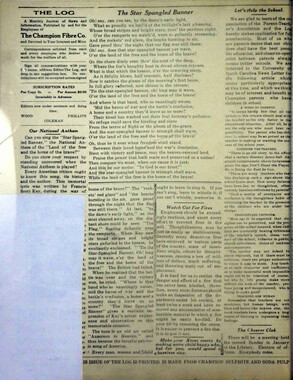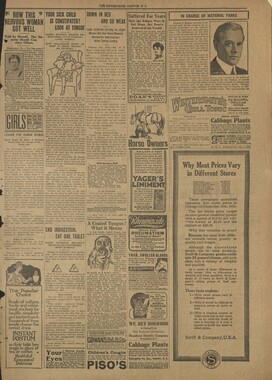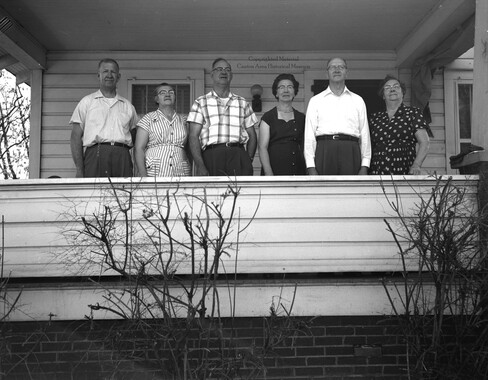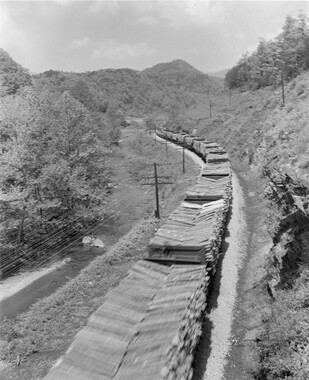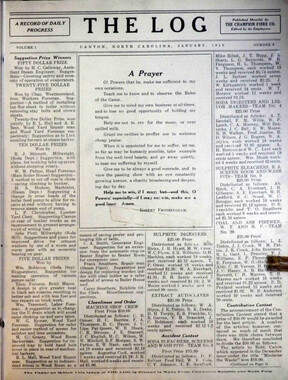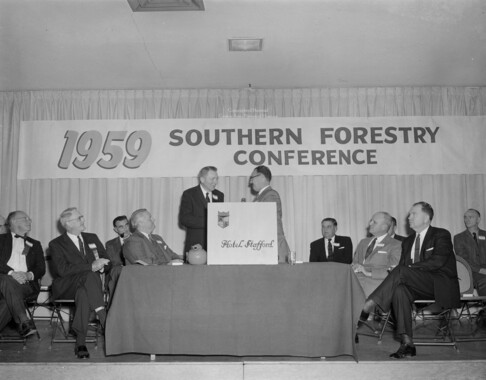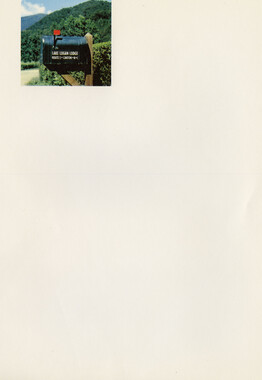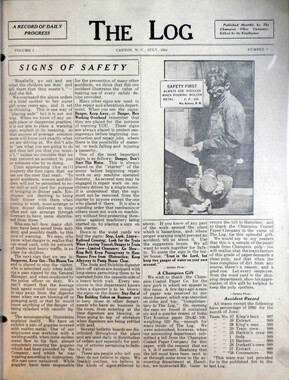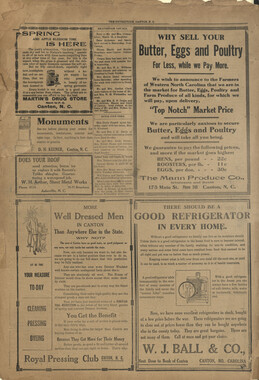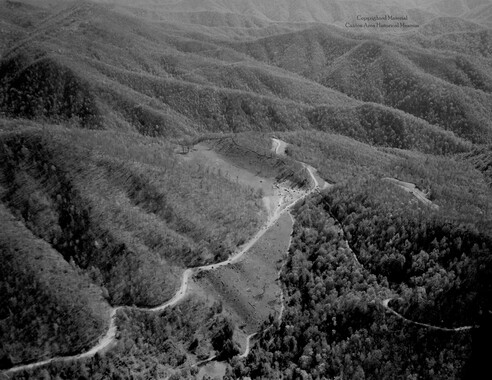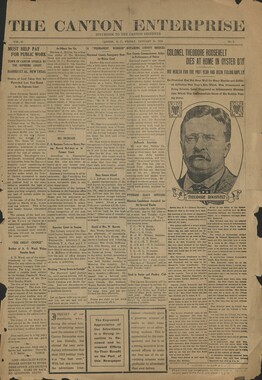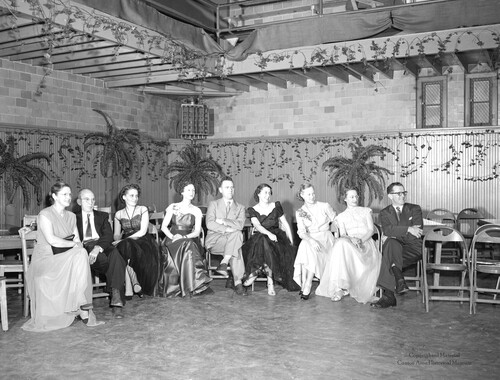Western Carolina University (2)
View all
- Canton Champion Fibre Company (22)
- Picturing Appalachia (22)
- Cherokee Traditions (0)
- Civil War in Southern Appalachia (0)
- Craft Revival (0)
- Great Smoky Mountains - A Park for America (0)
- Highlights from Western Carolina University (0)
- Horace Kephart (0)
- Journeys Through Jackson (0)
- LGBTQIA+ Archive of Jackson County (0)
- Oral Histories of Western North Carolina (0)
- Stories of Mountain Folk (0)
- Travel Western North Carolina (0)
- Western Carolina University Fine Art Museum Vitreograph Collection (0)
- Western Carolina University Herbarium (0)
- Western Carolina University: Making Memories (0)
- Western Carolina University Publications (0)
- Western Carolina University Restricted Electronic Theses and Dissertations (0)
- Western North Carolina Regional Maps (0)
- World War II in Southern Appalachia (0)
University of North Carolina Asheville (0)
View all
- Faces of Asheville (0)
- Forestry in Western North Carolina (0)
- Grove Park Inn Photograph Collection (0)
- Isaiah Rice Photograph Collection (0)
- Morse Family Chimney Rock Park Collection (0)
- Picturing Asheville and Western North Carolina (0)
- Champion Paper and Fibre Company (1)
- Allanstand Cottage Industries (0)
- Appalachian National Park Association (0)
- Bennett, Kelly, 1890-1974 (0)
- Berry, Walter (0)
- Brasstown Carvers (0)
- Cain, Doreyl Ammons (0)
- Carver, George Washington, 1864?-1943 (0)
- Cathey, Joseph, 1803-1874 (0)
- Champion Fibre Company (0)
- Cherokee Indian Fair Association (0)
- Cherokee Language Program (0)
- Crittenden, Lorraine (0)
- Crowe, Amanda (0)
- Edmonston, Thomas Benton, 1842-1907 (0)
- Ensley, A. L. (Abraham Lincoln), 1865-1948 (0)
- Fromer, Irving Rhodes, 1913-1994 (0)
- George Butz (BFS 1907) (0)
- Goodrich, Frances Louisa (0)
- Grant, George Alexander, 1891-1964 (0)
- Heard, Marian Gladys (0)
- Kephart, Calvin, 1883-1969 (0)
- Kephart, Horace, 1862-1931 (0)
- Kephart, Laura, 1862-1954 (0)
- Laney, Gideon Thomas, 1889-1976 (0)
- Masa, George, 1881-1933 (0)
- McElhinney, William Julian, 1896-1953 (0)
- Niggli, Josephina, 1910-1983 (0)
- North Carolina Park Commission (0)
- Osborne, Kezia Stradley (0)
- Owens, Samuel Robert, 1918-1995 (0)
- Penland Weavers and Potters (0)
- Rhodes, Judy (0)
- Roberts, Vivienne (0)
- Roth, Albert, 1890-1974 (0)
- Schenck, Carl Alwin, 1868-1955 (0)
- Sherrill's Photography Studio (0)
- Smith, Edward Clark (0)
- Southern Highland Handicraft Guild (0)
- Southern Highlanders, Inc. (0)
- Stalcup, Jesse Bryson (0)
- Stearns, I. K. (0)
- Thompson, James Edward, 1880-1976 (0)
- United States. Indian Arts and Crafts Board (0)
- USFS (0)
- Vance, Zebulon Baird, 1830-1894 (0)
- Weaver, Zebulon, 1872-1948 (0)
- Western Carolina College (0)
- Western Carolina Teachers College (0)
- Western Carolina University (0)
- Western Carolina University. Mountain Heritage Center (0)
- Whitman, Walt, 1819-1892 (0)
- Wilburn, Hiram Coleman, 1880-1967 (0)
- Williams, Isadora (0)
- 1880s (1)
- 1890s (1)
- 1900s (1)
- 1910s (1)
- 1920s (1)
- 1930s (20)
- 1940s (2)
- 1950s (2)
- 1960s (10)
- 1970s (7)
- 1600s (0)
- 1700s (0)
- 1800s (0)
- 1810s (0)
- 1820s (0)
- 1830s (0)
- 1840s (0)
- 1850s (0)
- 1860s (0)
- 1870s (0)
- 1980s (0)
- 1990s (0)
- 2000s (0)
- 2010s (0)
- 2020s (0)
- Asheville (N.C.) (4)
- Buncombe County (N.C.) (15)
- Haywood County (N.C.) (26)
- Madison County (N.C.) (1)
- Polk County (N.C.) (1)
- Appalachian Region, Southern (0)
- Avery County (N.C.) (0)
- Blount County (Tenn.) (0)
- Cherokee County (N.C.) (0)
- Clay County (N.C.) (0)
- Graham County (N.C.) (0)
- Great Smoky Mountains National Park (N.C. and Tenn.) (0)
- Henderson County (N.C.) (0)
- Jackson County (N.C.) (0)
- Knox County (Tenn.) (0)
- Knoxville (Tenn.) (0)
- Lake Santeetlah (N.C.) (0)
- Macon County (N.C.) (0)
- McDowell County (N.C.) (0)
- Mitchell County (N.C.) (0)
- Qualla Boundary (0)
- Rutherford County (N.C.) (0)
- Swain County (N.C.) (0)
- Transylvania County (N.C.) (0)
- Watauga County (N.C.) (0)
- Waynesville (N.C.) (0)
- Yancey County (N.C.) (0)
- Cards (information Artifacts) (1)
- Clippings (information Artifacts) (16)
- Envelopes (1)
- Manuscripts (documents) (1)
- Photographs (23)
- Portraits (1)
- Postcards (1)
- Publications (documents) (4)
- Aerial Photographs (0)
- Aerial Views (0)
- Albums (books) (0)
- Articles (0)
- Artifacts (object Genre) (0)
- Biography (general Genre) (0)
- Crafts (art Genres) (0)
- Depictions (visual Works) (0)
- Design Drawings (0)
- Drawings (visual Works) (0)
- Facsimiles (reproductions) (0)
- Fiction (general Genre) (0)
- Financial Records (0)
- Fliers (printed Matter) (0)
- Glass Plate Negatives (0)
- Guidebooks (0)
- Internegatives (0)
- Interviews (0)
- Land Surveys (0)
- Letters (correspondence) (0)
- Maps (documents) (0)
- Memorandums (0)
- Minutes (administrative Records) (0)
- Negatives (photographs) (0)
- Newsletters (0)
- Newspapers (0)
- Occupation Currency (0)
- Paintings (visual Works) (0)
- Pen And Ink Drawings (0)
- Periodicals (0)
- Personal Narratives (0)
- Plans (maps) (0)
- Poetry (0)
- Programs (documents) (0)
- Questionnaires (0)
- Scrapbooks (0)
- Sheet Music (0)
- Slides (photographs) (0)
- Sound Recordings (0)
- Specimens (0)
- Speeches (documents) (0)
- Text Messages (0)
- Tintypes (photographs) (0)
- Transcripts (0)
- Video Recordings (physical Artifacts) (0)
- Vitreographs (0)
- Norburn - Robertson - Thomson Families Collection (44)
- A.L. Ensley Collection (0)
- Appalachian Industrial School Records (0)
- Appalachian National Park Association Records (0)
- Axley-Meroney Collection (0)
- Bayard Wootten Photograph Collection (0)
- Bethel Rural Community Organization Collection (0)
- Blumer Collection (0)
- C.W. Slagle Collection (0)
- Canton Area Historical Museum (0)
- Carlos C. Campbell Collection (0)
- Cataloochee History Project (0)
- Cherokee Studies Collection (0)
- Daisy Dame Photograph Album (0)
- Daniel Boone VI Collection (0)
- Doris Ulmann Photograph Collection (0)
- Elizabeth H. Lasley Collection (0)
- Elizabeth Woolworth Szold Fleharty Collection (0)
- Frank Fry Collection (0)
- George Masa Collection (0)
- Gideon Laney Collection (0)
- Hazel Scarborough Collection (0)
- Hiram C. Wilburn Papers (0)
- Historic Photographs Collection (0)
- Horace Kephart Collection (0)
- Humbard Collection (0)
- Hunter and Weaver Families Collection (0)
- I. D. Blumenthal Collection (0)
- Isadora Williams Collection (0)
- Jesse Bryson Stalcup Collection (0)
- Jim Thompson Collection (0)
- John B. Battle Collection (0)
- John C. Campbell Folk School Records (0)
- John Parris Collection (0)
- Judaculla Rock project (0)
- Kelly Bennett Collection (0)
- Love Family Papers (0)
- Major Wiley Parris Civil War Letters (0)
- Map Collection (0)
- McFee-Misemer Civil War Letters (0)
- Mountain Heritage Center Collection (0)
- Pauline Hood Collection (0)
- Pre-Guild Collection (0)
- Qualla Arts and Crafts Mutual Collection (0)
- R.A. Romanes Collection (0)
- Rosser H. Taylor Collection (0)
- Samuel Robert Owens Collection (0)
- Sara Madison Collection (0)
- Sherrill Studio Photo Collection (0)
- Smoky Mountains Hiking Club Collection (0)
- Stories of Mountain Folk - Radio Programs (0)
- The Reporter, Western Carolina University (0)
- Venoy and Elizabeth Reed Collection (0)
- WCU Gender and Sexuality Oral History Project (0)
- WCU Mountain Heritage Center Oral Histories (0)
- WCU Oral History Collection - Mountain People, Mountain Lives (0)
- WCU Students Newspapers Collection (0)
- Western North Carolina Tomorrow Black Oral History Project (0)
- William Williams Stringfield Collection (0)
- Zebulon Weaver Collection (0)
- Education (2)
- Forest conservation (1)
- African Americans (0)
- Appalachian Trail (0)
- Artisans (0)
- Cherokee art (0)
- Cherokee artists -- North Carolina (0)
- Cherokee language (0)
- Cherokee pottery (0)
- Cherokee women (0)
- Church buildings (0)
- Civilian Conservation Corps (U.S.) (0)
- College student newspapers and periodicals (0)
- Dams (0)
- Dance (0)
- Floods (0)
- Folk music (0)
- Forced removal, 1813-1903 (0)
- Forests and forestry (0)
- Gender nonconformity (0)
- Great Smoky Mountains National Park (N.C. and Tenn.) (0)
- Hunting (0)
- Landscape photography (0)
- Logging (0)
- Maps (0)
- Mines and mineral resources (0)
- North Carolina -- Maps (0)
- Paper industry (0)
- Postcards (0)
- Pottery (0)
- Railroad trains (0)
- Rural electrification -- North Carolina, Western (0)
- School integration -- Southern States (0)
- Segregation -- North Carolina, Western (0)
- Slavery (0)
- Sports (0)
- Storytelling (0)
- Waterfalls -- Great Smoky Mountains (N.C. and Tenn.) (0)
- Weaving -- Appalachian Region, Southern (0)
- Wood-carving -- Appalachian Region, Southern (0)
- World War, 1939-1945 (0)
- StillImage (24)
- Text (21)
- MovingImage (0)
- Sound (0)
Canton is a community built sturdily on paper
-
This 1962 article gives an overview of Champion Papers, Inc. and its effect that it has had on the town of Canton, North Carolina.
-
-
Profile Of A Town-4. THE ASHEVILLE TIMES Monday, April 23, 1962 Section Two Road's A'Building Interstate Highway 40 under construction along the east-west route north of Canton will help correct what has for years been considered a hopeless traffic bottleneck on U. S. 19-23 in the town. Major highway improvements are also being made within the business section. This is an 1-40 overpass over Buckeye Cove road in the Thickety section just outside the town limits. Canton Is A Community Built Sturdily On Pape r By JAY HENSLEY CANTON - This is the town that was built on paper. Situated on the eastern rim of a dual-range wall of mountains that virtually surrounds Haywood County, it's first on the route from Asheville to the Great Smokies to the west. Its people are Champions, and from the surrounding forest- lands where their ancestors first found a livelihood comes the raw material that fashions the town's way of living today. The raw material is pulpwood and the product is fine papers. Mayor of the town Is Hazel W. Ramsey. George James is town manager. The board of aldermen consists of D. E. Morgan, Bill Stone and J. Patrick Greeley. Sam Reese is town clerk. They get together at 5 p. m. every second Tuesday in James' office on the second floor of the Town Hall to conduct the business of the municipality. From the window they can view the smoke-belching giant sprawled along the edge of the business district that makes Canton something more than just another mill town. Champion Papers, Inc., turns trees into fine papers and creates better living for many more than the 5,068 persons living within the town's corporate limits. It is Haywood County's largest industry. Before the advent of the paper mill in 1906, the town was barely a village in a county that was largely agricultural. Since that time is has moved from the status of a rural mountain crossroads to that of an industrial giant. Canton's division of what was then known as Champion Fibre Co. played a large role in that change, but Champion's Reuben B. Robertson, who has already become a legend among the South's greatest industrialists, made the paper mill a most helpful neighbor In a neighborly community. The young Yale-educated lawyer stepped from a promising legal practice into a brand-new Industry at a time when the country was reeling from blows dealt by the Great Depression. His first experiences here called for extra reserves of strength and optimism. It was a time when scientific forestry in the South was little more than a phrase on the tongues of a few far-sighted pioneers. Manufacturers—short on markets and watching raw materials pile up high as their smokestacks—were afflicted by an "economy of abundance." Peter G. Thomson, Hamilton, Ohio, Industrialist, had built the plant here as a pulp supply source for his paper firm in the North. The strain of keeping up with obligations made Then And Now Reuben B. Robertson, former president and chairman of the board of directors of Champion Papers, Inc., is shown in upper photo as he appeared about 1906 when Champion Fibre Co. first started operations in Canton. In 1950 he was named The Man Of The South. prior to the 1905 crash robbed him of his health, and his son- in-law was sent here as his representative. Reuben Buck Robertson, a native of Cincinnati, Ohio, immediately saw beyond the abundance — to the day of naked coves, exposed hills and little timber. The vision kindled a dynamic interest that led to leadership in Southern forestry and forest conservation as well as industry. The man who became plant manager of Champion and later president of the firm recalls that Canton was a crossroads village when he made his first visit. The railroad had scaled the mountains and the depot was a stop-gap for travelers between Asheville and the west. Charles F. Smathers was postmaster. The 10-year-old iron and timber bridge across Pigeon River took some of the toil out of travel for those who spurned the railroad. Befor the bridge was built in the 1890s, travelers and their livestock would ford the river at this point. The practice resulted in one of several names by which the town has been known—Pigeon Ford. A canoe was provided for foot-travelers. Canton's "Big Four" of that day — Pop Hampton, Nelse Mease, Charley Wells and Turner Sharp—were the original contacts when the Ohio firm started negotiating for a plant site here. On one occasion they decided the utmost frankness was due the industrialist from the North—and told him that the town was plagued with a serious debt problem. There was a total of $300 in unpaid town obligations. Total assessed valuation of property in Canton today is $13,236,546 with a bonded indebtedness of $80,000. The average weekly wage of the industrial worker about $135. The town is presently spending $12,000 to complete a comprehensive development plan as a guide to future growth in a logical and desirable manner. The tax rate is $1.89 per $100 valuation. Of the 3,300 working members of the total population, only 100 of them travel 10 miles or more outside the eoporate limits of the town to their jobs. And the limits are not large—1,091.1 acres — to be specific. Canton is located 18 miles west of Asheville where U. S. Highway 19-23 starts its long, straight pull from the floor of the valley to the crest of the Newfounds—a ,mountain range in the shadow of which the three-lane thoroughfare manages to remain until it reaches the corporate limits of the town. Here it becomes Canton's Church street, twists tortuously downgrade past the intersection of Main street and the Heap O' Logs; Big Payroll Times Photos by Malcolm Gamplt Champion Papers, Inc., virtually Canton's only industry, makes up the size what the town lacks in diversity. It presently employes 2,- 550 persons and can produce 2,003 tons of pulp, paper and paper- board every 24 hours. This plant vas the first mill to make white pulp from chestnut trees and the firJjt to manufacture bleached hardwood pulp by the sulphate process. The plant uses approximately 1,- 500 cords of pulpwood in 24 hours. One single machine in the mill can produce more than a mile of paper every three minutes in a sheet 230 inches wide. One resident of the town describes the heavy odor that accompanies the papermaking process as "the delightful payroll aroma." Champion's annual payroll is approximately $18,- 500,000. Town Hall, where it shifts onto Park street. Out of the hustle and bustle of toe business district, and alter some little distance across Pigeon River, the main thoroughfare unloads its traffic onto Clyde street, which widens west of the town limits and again becomes the Tomahawk Trail—U. S. 19-23 to the Great Smoky Mountains National Park, Knoxville and Atlanta. Long considered a traffic bottleneck to Haywood's tourist flow, bridge and road projects now underway will cut traffic congestion to a minimum in Canton. Riding high along the crest of the mountains from a point some two miles east of town in Buncombe County is a red- earth roadbed that will extend dual-lane Interstate Highway 40 west of Canton to a connector highway at Clyde. Known as the Canton By- Pass, the $3,200,000 1-40 link was started a year ago in June by the State Highway Department, and is expected to be completed by June, 1963. It will add 5.33 miles to the Interstate system in this section. Another state-federal project which will open Main street to a new width, straighten some curves and add a new bridge over the Pigeon River is also now underway. It is costing the town at least one large brick building and shaving the fronts from several houses, but even at the cost of $176,173.88 to the state and federal governments the project would seem well worthwhile. ping centerv-Main street—in a wide, straigk course with four- lane U. S. 19-23 west of the Pigeon Rive} Major means of crosslnf the stream at present Is th* concrete Pidgeon River Brkfgf constructed by the State Hfeiway Department in 1924. Trie one-lane iron and timber :e that spans the river just of the point where the structure is being built ive this town the name it now carries, according to a legend that has fairly well been accepted as fact. The plank-bottomed bridge, which is supported by an iron overhead suspension superstructure, will likely be torn down when the new concrete bridge is completed — but the town fathers plan to preserve the manufacturer's nameplate. The plate, located directly Overhead at the east end of the narrow bridge, says "Wrought Iron Bridge Co. — Builders— Canton, Ohio." When the railroad first came to this section in 1881, a depot was built here and the village that had been called Pigeon River since the first settlers arrived was named Buford in honor of the railway's president. Its original name came from the stream, and the river, according to some historians, was so named for the birds that flocked to its banks. At any rate, both the river and the village were known as Pigeon River when the post office was first established on April 4, 1837. There had been a series of name changes—historians differ slightly as to what and when at times—but it was Pigeon River again in the late 1890s when folks started thinking about selecting a more sophisticated title for their town. And according to the legend, the town fathers were gathered around the council table in the Town Hall attempting to settle the issue when one of them tired of the hassel and walked out onto ihe bridge for a breath of air. It was then that his eye fell upon the address of the Ohio bridge builder in the nameplate over the span, according to the legend, and he went back to the town hall and had little difficulty selling the name "Canton" to his fellow lawmakers. Whether the legend has any basis in fact or not, the name of the Ohio town was transplanted to this Western North Carolina municipality as firmly as were a few years later Reuben Robertson and an offshoot of the Champion Coated Paper Co. of Hamilton, Ohio. The lawyer-turned-plant-manager in later years noted that he had been sent here "because Champion's ox was in the ditch." There was discord among the Canton executive personnel, and it was his job- originally designated as one of some 60 days duration—to set things right. Robertson set up what was known as "dinner crowd" conferences in 1907 to establish a "cease fire" among the warring executives. That innovation has been carried forward for more than half a century now and is today standard practice in all Champion mills. Canton's police department, headed by Chief Bill Stroupe, consists of 10 regular men and two extras. H. L. Setzer is chief of the fire department which includes six fulltime men and 20 volunteers. The Haywood County Rescue Squad, with a 50-man volunteer force, maintains one truck and full equipment at Canton with Walt Price as captain and Jennings Pressley as first lieutenant. Street lighting, rated the best per capita in the state, is provided by Carolina Power and Light Co. Southern Bell Telephone and Telegraph Co. has recently installed new dialing equipment. The water supply, municipally-owned, is from surface sources and the town has a 1,250,000-gallon storage facility. Home ownership in Canton is estimated at 90 per cent. Neat lawns and stone retaining walls characterize the residential sections of the town. Ninety per cent of the streets are paved and residential thoroughfares are swept once a week. Sweeping is a daily chore for the crews that maintain the streets in the business section. The population of Canton 60 years ago has been estimated at 300 persons. Today 2,863 students are enrolled in the Canton School System which includes five elementary units, one high school, a junior high school, and one union school. A retired superintendent of the Canton school system, A. J. Hutchins, who went there In 1924 from Asheville High School where he was then serving as principal, organized what now appears to have been the granddaddy of the consolidation system. Canton today is the only town in Haywood County that has its own school system. In the mid-1920s town support was limited to schools within the corporate boundaries, and there was a rim of tiny county schools just outside the area. Approval of the county board of commissioners was gained for an election, and the voters approved a special tax and extension of the school district to include six two-teacher schools, two one-teacher units, and one five-teacher and one six-teacher schools. The superintendent made a double-barreled consolidation out of the move by combining the small schools into three elementary units and consolidating the high schools into a single unik-with the exception of the one union school. A 50 by 25-foot vocational education building was constructed within a three-week period at a cost of only $1,900 during the early 1930s. Hutchim secured assistance from teachers and high school students on that job, and brick masons from Champion, and was ready for the training program three weeks after the appropriation was made for the project. Adult vocational education programs are carried out in (Continued On Page 13) Stadium And High School Almost 2,000 students are currently enrolled in Canton High School. Left background junior high school. There are five elementary schools in the town's school system. In the foreground is the high school's football stadium, which was constructed in 1941. Vocational education buildings are located at the rear of the school. Main Street To the left is Canton's Main street, which is now undergoing extensive improvements including a new bridge under construction across Pigeon River and new width at the Water street approach. To the right is Park street—for years a bottleneck on U.S. 19-23 through (Canton. Completion of the Canton By-Pass now under construction will also relieve much of the congestion.
